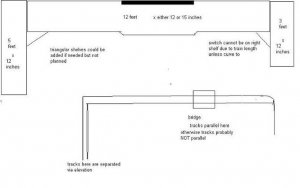I am a newbee to the model railroad hobby. I live in a mobile home so am very limited to the space for a layout.
I have decided on a shelf layout (see diagram below). I need help on some of the design factors. I already have the train set for the layout. It is a Klein modelbaun locomotive and two passenger cars. I plan on use circuitron's automatic
reverser unit to make the unit traverse the layout.
Here are my questions (please study diagrams below before answering):
1)With regards to the left and right side of the layout what is the max radius curves that I can have?
2)Which type switch should I use (wye, Curve turnout, turnout, or single crossover)and which size would be the best (4,5,6,8,10,etc)?
(KEEPING IN MIND:
That part of the track on that side of the layout will be parallel. I already have a dual track bridge built that I
want to use and train equipment that I have.)
3) Should all the track be level or is it an acceptable practice to slightly tilt the track possibly in one or more of the curves?
Thanks in advance for any help.
http://www.the-gauge.com/attachment.php?attachmentid=33166&stc=1&d=1166519119
I have decided on a shelf layout (see diagram below). I need help on some of the design factors. I already have the train set for the layout. It is a Klein modelbaun locomotive and two passenger cars. I plan on use circuitron's automatic
reverser unit to make the unit traverse the layout.
Here are my questions (please study diagrams below before answering):
1)With regards to the left and right side of the layout what is the max radius curves that I can have?
2)Which type switch should I use (wye, Curve turnout, turnout, or single crossover)and which size would be the best (4,5,6,8,10,etc)?
(KEEPING IN MIND:
That part of the track on that side of the layout will be parallel. I already have a dual track bridge built that I
want to use and train equipment that I have.)
3) Should all the track be level or is it an acceptable practice to slightly tilt the track possibly in one or more of the curves?
Thanks in advance for any help.
http://www.the-gauge.com/attachment.php?attachmentid=33166&stc=1&d=1166519119


